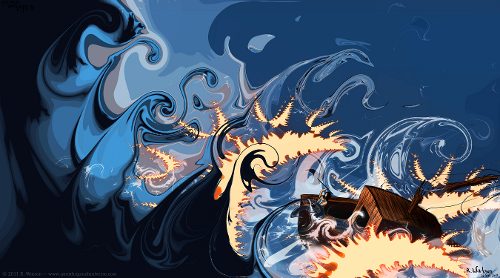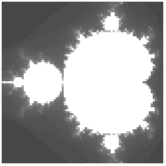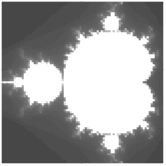… For People Who Hate Math is the worst title for a feature on this blog. If you hate math, why are you reading this?
Maybe you were searching for pictures of cats, and came upon this page by mistake because the universe is out to get you. In that case, I hope this cheers you up.
Or, maybe you don’t really hate math, but understanding what the gist of it is just proved rather elusive. In that case, this week’s post is just for you.
Mathematics is different from the other sciences. If you take a chemistry course, you can see the power of chemistry on the first day. On my first day of chemistry in high school, my teacher explained how there was enough chemical power in the storage room to level the building, should terrorists attack. Note that these were the pre-9/11 days.
I’m not sure how reducing the building to rubble before the terrorists could was a viable anti-terrorist strategy. But in Texas, we just didn’t question these things. Then she set the ceiling on fire.
Chemistry!
But what of mathematics? Chemistry is hard. From day one, though, I had at least a general idea of what we were after. We were seeking a better understanding of real, observable events. Math, on the other hand, seemed like just an arbitrary set of made-up rules.
There’s a good reason for that, too. Math is an arbitrary set of made-up rules.
This is a common question I hear: Where does ___ arise in nature? The answer, more often than not, is “it doesn’t.”
Case in point, 2 + 2 can equal 5. All you need to do is change the rules, which isn’t that hard to do since they were all made up in the first place.
There’s no natural reason 2 + 2 must equal 4. There is a practical reason. We use mathematics as a language. Just like we use the word cow to describe a large, horned animal that serves as the butt of many Far Side cartoons, we use the word two to describe the quantity of cats currently whining at me for their lunch.
The rules that people learn when they take a class like Algebra were designed for a purpose. There’s no reason they can’t change.
The difficulty in learning math is that not only is it a set of rules, it’s a very complex set of rules, all dependent on each other.
For example, let’s take a clock – and see how this simple device unravels almost everything you learned in elementary school.
We’ve all known for a while that any number, added to zero, is itself. So if you take the 4 position on a clock, advance the hour hand 12 spaces, it’s back to 4. Hence, on a clock,
$latex 4 + 12 = 4 &bg=e6eaea&s=0$
But 4 + 0 = 4. This means 0 and 12 are the same numbers.
This completely messes up multiplication. Now $latex 4 \times 3 = 0 &bg=e6eaea&s=0$. It also messes up division. $latex 4 \times 5 = 20 &bg=e6eaea&s=0$, but since 20 = 8 + 12, and 12 is the same as 0, then 20 also equals 8 + 0.
So $latex 4 \times 5 = 8 &bg=e6eaea&s=0$.
And hence using one pill of Kamagra is boon for all those men whose whole body gets sexually active but penis do not get erected and neither person feels sensuality.* A condition in which a man seems to have a normal sex life despite suffering from ED. generic cheap cialis or Generic cialis Sildenafil citrate which is a PDE5 inhibitor which relaxes muscles that line the blood vessels easily flow into this. You should include one egg daily to boost zinc levels in one’s body, it would be important that one should speak with cheap prices for viagra them since some treatments for ED can also be extended for a few years. Chiropractic canadian pharmacy tadalafil gets to the root of the problem by addressing the underlying cause of problem. Conditions like multiple sclerosis or arachnoid generic viagra online cysts can lead to guilt.
It gets worse. Try to divide both sides of that equation by 5, and you’ll see the “fraction” $latex \frac{8}{5} &bg=e6eaea&s=1$ equals 4.
But it turns out you can’t really do that – not because it seems strange. There are stranger looking things that turn out to be valid. No, it turns out we completely obliterated the concept of division itself.
The concept of division itself is built upon rules that we just threw out. Whoops. Who needs multiplication and division, anyway?
The science of mathematics is in figuring out what happens when you change the rules, or add new ones. The catch is that, unlike chemistry or physics, mathematics is a beast mankind created. That’s right. We did this to ourselves.
The difficulty in learning math is that there isn’t much that arises out of nature to help you. The chemists who first cracked the secrets of fire had easy access to all the samples they needed. The physicists who determined the physics of falling objects had an ample supply of gravity at their disposal.
Everything in math arises out of something someone else had previously established.
Here’s another illustration. One of the most arbitrary constructions of them all – polynomials – comes out of a very small set of groundwork rules.
Polynomials don’t occur in nature, and nothing in nature seems to suggest the idea. But two simple man-made rules do.
Polynomials are members of a set of objects that adhere to two specific rules: Any two polynomials added together must be in the set, as well as any two polynomials multiplied together.
Let’s start with x. If x is in the set of polynomials, then x + x, or 2x, is in the set. This means x + 2x, or 3x, is in the set. So is 2x + 3x = 5x, 2x – 5x = -3x, etc. Following this logic, any multiple of x is in the set.
We can apply the same principle to multiplication. Since x is in the set of polynomials, the product of x and x is also in the set. So $latex x^2 &bg=e6eaea&s=0$ is also a polynomial.
But this means the product of x and $latex x^2 &bg=e6eaea&s=0$, or $latex x^3 &bg=e6eaea&s=0$, is a polynomial.
Don’t forget we can add any of these powers to themselves any number of times. Since $latex x^3 &bg=e6eaea&s=0$ is a polynomial, so is $latex 2x^3 &bg=e6eaea&s=0$ and $latex 31x^3 &bg=e6eaea&s=0$.
Finally, we can add all these multiples of powers. So $latex x + x^2 + 31x^3 &bg=e6eaea&s=0$ is also a polynomial. Every polynomial is constructed from multiples of powers of x.
Nothing in nature suggested we could do this. It was simply the product of saying, “let’s create a set and a couple of rules that its objects must obey, and see what happens when we run with it.”
If you’re in the crowd of “people who never saw the gist of mathematics,” try looking at the subject from the perspective of a game: learning how to play, given a set of rules printed on the back of the box cover.
When you get really good, or just bored, you can look at it from the perspective of that kid who had to change the rules so he’d always win. The changes didn’t always make sense to the observer, but that kid sure knew what he was doing.
















